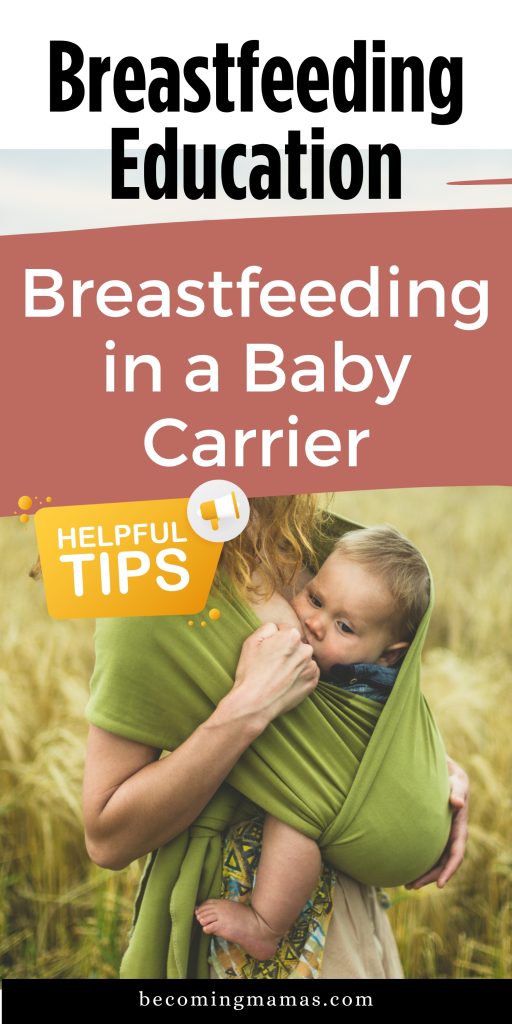Breastfeeding is a beautiful and important part of growing your child, but it isn’t really restricted to the comforts of your home. Sometimes, your baby needs to feed when you’re in a grocery store, at a park, travelling, or even at family gatherings.
Here’s where learning how to breastfeed in a carrier becomes a lifesaver. With the proper and safe technique, you can feed your baby discreetly, comfortably, and hands-free, all without cutting your day short.
More than bringing comfort to daily life, an infant travel carrier can also support your breastfeeding journey wherever you may be.
In this guide we will discuss about the safety considerations of feeding in carriers, best carriers for nursing, positioning tips, and what clothing is advisable to make on-the-go breastfeeding easier.

Is it safe to breastfeed in a baby carrier?
When it’s done the right and proper way, yes, breastfeeding can be done in a carrier safely. Since babies, especially newborns, have developing airways and limited head control, proper positioning is very important. The safety of your child should always come first; here are some guidelines to help you:
- Check Your Baby’s Airway First: Always have your baby’s nose and mouth visible and not pressed against anything like clothing or even your body.
- Correct Safe Positioning: Never let a baby curl into a “C” or slouch, as this can limit or make it harder for them to breathe.
- Supervised Feedings: Never breastfeed in a carrier while lying down, sleeping, or in any manner that leaves your baby unattended.
Think of the carrier as a tool, that frees up your hands and provides support, but with your attentiveness, it ensures that the feeding experience is both safe and soothing for the both of you.
The best types of carriers for breastfeeding (wraps, slings, soft structured)
Different carriers offer various types of support for nursing your infant; the right choice for you will really depend on your body, your baby’s age, your preferred feeding style, and how comfortable you feel. Here’s how the most common types of feeding compare:
- Wraps—Most wraps are made from stretchy or woven fabrics that are soft, versatile, and beginner-friendly. They allow you to adjust the fabric for cradle-style or upright nursing. Compared to other carriers, a wrap-style carrier may lack support for older and heavier babies.
- Ring Slings are more commonly used because they allow quick adjustments. You can easily loosen the fabric slightly to bring your baby to breast level without fully removing the sling. This type of carrier is ideal for younger infants and for parents who want easier access.
- Soft Structured Carriers (SSC) are more supportive for bigger babies and longer outings. While they are not as easy to adjust as a sling, many SSCs allow for upright breastfeeding once you’re comfortable with strap adjustments.
- Infant Travel Carrier offers convenience, especially when travelling, but it can also double as a feeding tool during flights, long walks, or sightseeing. It’s best to try for models with breathable fabrics and adjustable panels for quick access.
Each type of these carriers has their advantages and disadvantages, but to most parents, a ring sling or soft structured carrier are the most practical for on-the-go nursing.
When the baby is ready: signs it’s safe to try nursing in a carrier
It’s tempting to start nursing with a carrier right away, but newborns need some time to establish breastfeeding and gain a bit of strength and control before you nurse in a carrier. Here are some signs that your child may be ready to nurse in a carrier:
- Consistent Latch. When your baby can latch easily without the need for constant repositioning.
- Good Head Control. Full head control would take months, but your baby should have enough neck strength to adjust slightly without collapsing.
- Regular Feeding Pattern. You’ve learned your child’s hunger cues and know when they’re likely to nurse calmly.
- You’re more confident holding your baby at the breast. Before adding the complexity of a carrier, both of you should feel comfortable nursing in your arms.
Commonly, parents would start experimenting with how to breastfeed in a carrier when their baby is between 4 and 8 weeks old, depending on comfort and feeding confidence.
Positioning tips for both upright and cradle-style nursing
Your nursing style will depend on both your baby’s age and your preferred feeding style.
- Upright Nursing (this is the most recommended position for most ages) is comfortable in structured carriers, wraps, and slings. Hold your baby tummy-to-tummy with you, with the chest upright. Loosen the straps or fabric slightly to bring your baby to breast height. Support your baby’s head gently, guiding your baby to latch. After your feeding session, always readjust to a snug and comfortable position.
- Cradle-Style Nursing (best for newborns in wraps or slings) The baby is resting across your chest in a horizontal position. The fabric supports their body while your arm supports the head. Use caution: baby’s chin should never be pressed into their chest. This position is less hands-free but more natural for younger babies.
Additional Tips: Practice at home first, so both you and the baby are comfortable before trying in public.
Keeping the baby’s airway clear during feeding
One of the most important parts of carrier breastfeeding is airway safety. Always remember the “visible and kissable” rule:
- Baby’s face should be visible at all times.
- Baby’s head should be close enough to kiss without straining.
- Chin should be off the chest with at least a finger’s width of space.
- Nose and mouth must remain uncovered by fabric or breast tissue.
While you’re nursing, it’s common for fabric to shift or baby to slump slightly, so check frequently. This is especially true if you’re busy or in a distracting environment.
What to wear: Nursing-Friendly Clothing for On-the-Go
The right clothing can help or be a hassle in your experience when figuring out how to breastfeed in a carrier. Nursing-friendly outfits give you the best access without too much fumbling.
Best Options:
- Nursing Bras. These are especially designed garments that have clip-down or pull-aside styles, which help make feeding easy.
- Wrap Tops or Button-downs. They give you quick access without having to undress all the way.
- Loose Tees or Tank Layers. It’s easy to lift from the bottom or pull aside discreetly.
- Nursing Covers. If you prefer more privacy, these lightweight covers help you cover up, but choose the ones that don’t obstruct airflow.
Understanding how to use these types of clothing with a supportive infant travel carrier will allow you to feed comfortably in public without drawing too much attention.
Common Challenges That Could Arise and Helpful Solutions
Even experienced parents may run into obstacles and different challenges when learning to breastfeed in a carrier. Here we share some solutions:
- When Your Baby Won’t Latch Upright. What you could do is try the cradle position first or use a ring sling for easier access to help in transitioning to an upright position.
- Discomfort for the parent while feeding. Adjusting the shoulder straps or trying a different carrier style that’s better suited for your body could help.
- Too Much Fabric In The Way. You could try practicing loosening and re-tightening the carrier without removing your baby at home.
- Worried about exposure. Layer your tank tops and nursing bras for extra coverage.
Like any new skill, practicing builds your confidence.
Conclusion
Learning how to breastfeed in a carrier is one of the most useful skills to acquire for modern parents. It enables you to feed your baby while having your hands free, whether you are at home, doing errands, or traveling. Breastfeeding in a carrier is mostly safe when done with attention and proper positioning considering the airway safety.
Carriers like wraps, ring slings, and soft structured carriers are the best choices, with an infant travel carrier being especially useful for longer outings. You should wait until your baby shows signs that they are ready to be breastfed while in a carrier; these signs include a strong latch and better head control. Practicing both the upright and cradle-style positions, keeping the baby’s airway clear at all times. Wearing nursing-friendly tops and clothing can help simplify the process.
With the right carrier, preparation and sufficient knowledge, you’ll have the freedom to go anywhere without worrying about where or when your baby will need to feed.

Last Updated on August 28, 2025 by Tania Nizova | Published: August 28, 2025

Mom of 3-year-old superhero Michael and 7-year-old princess Stasia. 👩👧👦
Passionate about research and getting to the core, enjoying processing information & always hungry for more. 📖
Learning & sharing how to be a better mom. Join me, and let’s grow together! 🌼
